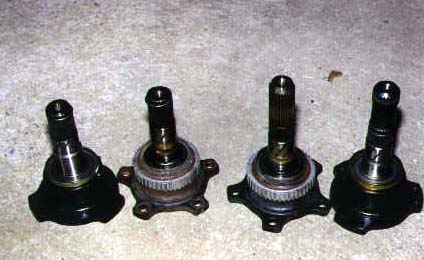
I purchased my '95 240 in January of '99 and decided to become envolved with SCCA Solo II events. Well after my first race I was hooked. Most Solo II courses are designed for relatively low speeds (you probally won't ever get out of 2nd gear) and contain numerous turns. After my first competition I realized that when exiting a turn under full throttle it's relativly easy to spin the inside wheel, a problem inherant of open differentials. My solution was to replace the open differential in my 240 with the viscous limited slip unit available as an option on the SE models.
Why is a Limited Slip Differential(LSD) better than an open differential? A LSD is better because it allows power to be applied to the ground in a more controlled fashion. In an open differential setup if one wheel begins to spin faster than the other, more power is transferred to the wheel that is spinning fastest (this is a problem when you dump the clutch for instance.. because you spin one wheel faster, more power is transferred to that wheel, making it spin even faster which transfers even more power spinning it faster... this perpetial cycle only ends when the spinning wheel decides to grip the pavement). This is fine for the average driver because they won't worry about how quickly and affectivly his or her engine will get it's power to the ground. For sports car drivers, this matters. A LSD (in its various forms that I will discuss later) wheel try to keep the power output of each wheel balanced equally, ie if one wheel begins to spin faster than the other, more power is transferred to the wheel that is spinning slowest. Now that the differential difference is as clear as mud we can move on.
How does a Viscous LSD(VLSD) work? each output shaft of the differential is tied together by a device known as a viscous coupling. This is basically two slotted discs that have a silicon fluid between them. If the discs are rotated at a speed that varies relative to each other this produces friction which heats the silicon fluid up. The silicon becomes more viscous as it's temprature rises. There will be a point where the silicon will become viscous enough to hold the two discs together (this is why the discs are slotted, it is so the silicon will have something to grip to).
Where do I get a VLSD to put in my 240sx? By far the easiest and most inexpensive way would be to find a VLSD from a 240. I'm not sure but I believe the differential housing is the same for all model years of the 240sx. Another solution would be to get a differential from a 90+ 300zx. This is more expensive but they are easier to find. If you decide to use a differential from a 300zx be sure that it is from a '90+ model naturally aspirated one and NOT from a twin turbo. The NA version has a gear ratio that is equal to the 240sx (4.083:1) while the twin turbo uses 3:61:1. I will tell you if I had to do it over again I would use the VLSD unit from a 240. the 300zx unit is identical internally but you have to replace the output shafts so that it can bolt up to the 240's drive shafts. So you can buy a used differential from a 240 for about $300 and change or you could get a used unit from a 300 for $300 and change and then spend another $300 on making it fit in your car.
Now.. on with the install. Lay everything out that you're going to need.
the following are non esscential but make life easier,
Here's what my install involved since I used a rearend from a naturally aspriated '93 300ZX, if you luck out with one from a 240, you can go straight to removing the old differential.
.

First I had to remove the output flange/spline from the differential (this is what bolts to the driveshafts). The bolt pattern is different on the 300zx than it is on the 240. You cannot interchange the ones from an open differential to the limited slip differential, internially they are different, so don't try it. Here's a picture of the ones from the 300zx (center) and the new ones I bought from Nissan (outside... those are about $150 a piece from nissan).
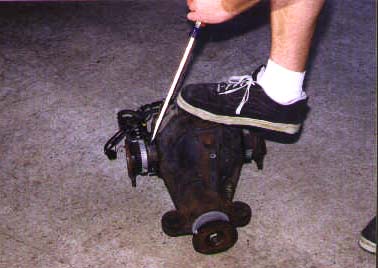
The shafts are held into the differential by a C-clip. You remove the shafts by simply prying on them like I am doing in the picture. A quick and deliberate motion works best. It shouldn't take a great amount of force.
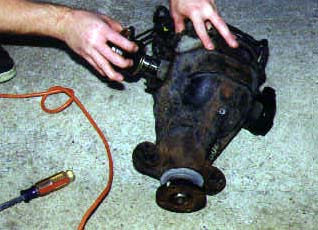
Once you get them loose, carefully remove them from the differential, you don't want to damage the oil-seals. After they are removed, inspect the oil seal. If they appear damaged now would be a good time to replace them. Oil/grease on the sides of the differential might be an indication that you need to replace them, luckily mine were fine.
Install the new flanges/shafts by carefully sliding them into the differential in the same manner that you removed the old ones. Apply pressure evenly until the C-clip catches.
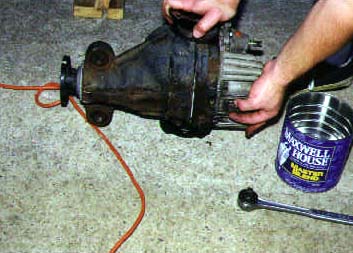
After replacing the shafts on each side, it would be a good time to replace the oil in the differential. Nissan recommends using 80W-90. I didn't bother using synthetic since the autoparts store didn't have synthetic, and dino oil works just fine without any problems. Use a socket wrench to remove the drain plug on the bottom of the differntial. Have something close by to empty the oil into. Drain the old oil and remember to put the plug back. Torque it somewhere between 29-43 ft/lbs.
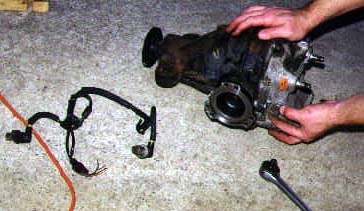
Now remove the filler plug (on the side of the rear cover). You can see the ABS sensors on the left in this picture. I'm not sure if you can use these if you have ABS on your 240. I don't have ABS so I just removed them.

Make sure that the differential case is level (I had to prop the front up). Fill with your chosen gear lube. It should take about 1.5 quarts. Fill until the oil is level with the bottom of the fill hole. Easiest way to do this is just fill until oil begins to come out. Replace the filler plug and torque somewhere between 29-43 ft/lbs.

Now we remove the open-differential from the car. Jack the back of the car up and place jack stands under each side. Look at that old greasy rear cover. It appeared that my left side-oil seal was leaking. A good excuse to just replace the entire differential with a limited slip unit :)
I don't have pics of ever step now because I couldn't work and take pictures at the same time, but the process isn't difficult.
There are four bolts holding the propeller shaft to the input flange of the differential. There are 6 bolts holding each half shaft to the output flanges. If you have a manual transmission put it in 5th gear and set the parking brake. You'll have to remove as many bolts from each side as you can, release the parking brake and put the care in neutral, move the wheels until you can get the more bolts, and set the parking brake and put the care in 5th again. After you get the four bolts off of the proepller shaft, pull the shaft away so that you wont damage it. A good place is to prop it up on the exhaust.
There are two studs that are attached to the rear cover of the differential. These go through a cross memeber and have two nuts attached to them. On the left side there's also a grounding strap that's attached with another nut. Remove these nuts.
At this point there are only two bolts remaining, the two that hold the front
of the differential housing up. Before removing these support the weight of the
differential with a jack. DIFFERENTIALS ARE HEAVY. BE
CAREFUL. Remove the two bolts that hold the front of the
differential up. Slide the jack/differential towards the front of the car so
that the two studs are clear of the cross-member. Slowly lower the jack, while
balacing the differential. The driver side output shaft will get caught on the
exhaust if you lower it straight down. It takes some muscling to get it passed
the exhaust. Be sure the drive shafts and the propellar shaft are clear of the
differential. Now lower the jack all the way and get that old differential out
of the way.
Take the two nuts you removed from the studs on the rear of the differential. Try putting them on the LSD unit. Making sure they are the right size now will save you trouble. If they don't go on smoothly, make sure the studs arn't dinged up and that they are the right size thread. If they fit good then you are ready to install the LSD.
Balance the LSD on the jack and roll it under the car. Jack it up slowly making sure you clear the exhaust. As you probally found out removing the open-differential the drive-shafts have a cup that makes them "male" and the output flanges of the differential "female". It's easier to get them back into place before you get the differential all the way up, so do that now (but don't put any bolts in). The front of the differential is held up by two bolts and a few other things..You should have a bolt, then a large washer, then a rubber dampener, the differential, and then a rubber/metal piece that isolates the differntial from the car. If not do not pass Go and do not collect $200. After jacking the differential all the way up, put the two front bolts back in (along with the other goodies I just mentioned). Don't tightenen them down all the way yet. Put the two nuts back on the studs that hold the back of the differential up. This is where a torque wrench is useful these nuts should be torqued between 72-87 ft/lbs. More than that and you'll break the rear cover. Unfortunately this happened to me (pictures of the broken cover below). Torque the two bolts that hold the front up somewhere between 72-87 ft/lbs. Now you get to put all the bolts back into the propeller shaft (41-48 ft/lbs) and drive shafts(25-33 ft/lbs). That should be everything, except the grounding wire. I'm not sure what it's function is but I removed it from my car. Someone e-mail me if you know what it's purpose in life is.
Check for any oil leaks. Double check that all bolts are in place and torqued
to spec. Remove jack stands, and take a short test drive (somewhere around a
mile). Inspect once again to make sure nothing is leaking. I had a cracked rear
cover, which caused oil to leak which coated my gas tank nicely. I had to remove
the differential, drain the oil, remove the rear cover, and replace it with the
cover from my old differential (which luckily is the same on all 240sx model
years). The rear cover on the 300zx rear-end is beefier, it has some nice
cooling fins but these arn't needed on the 240 since it doesnt produce nearly as
much horsepower or have the top speed the 300zx has.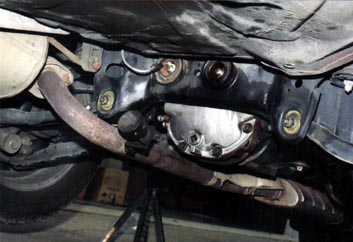
Here's we have the VLSD unit from the 300zx on the car and ready to go. Notice the dark spots on the gas tank? Thats the oil that leaked from the broken rear-cover. This is why its good to inpsect everything before you go driving cross country or do a bunch of donughts in a parking lot.

Here's the broken rear cover. $80 to replace it with a new one from nissan. This is why I suggest investing in a torque wrench. It'll pay for itself.
After driving my car with the LSD in, I can definately say it makes a big difference. The rear of the car doesn't have a tendency to swing out like it once did. And I can apply power quicker coming out of a turn. Was well worth the time and effort it took.
People keep asking me about part numbers for the flanges. The part numbers I
have, which are old, are as follows LEFT:
38220-52F01
RIGHT:38220-92L00
That should give you some kind of guidance
as to what you are looking for.
I hope that covers everything on your swap.